All batsmen need a plan for batting against the yorker! Modern cricket often requires teams to score runs at a very fast rate, and the yorker is one of the most difficult deliveries for a batsman to attack and defend against! This means that in order to keep those scoring rates up, we have to get creative when facing them! Thankfully, batsmen have come up with some excellent attacking and defensive strategies in the last decade, and in this post I’m going to teach you exactly how you can add these strategies to your game too!
To bat consistently well against the yorker, you must develop and add to your technique in the following areas:
- Detecting the yorker
- Defending against the yorker
- Changing your body position at the crease
- Shots that you can play to attack the yorker
It is those four areas that I’m going to concentrate on in this post. My main aim is to give you the options that you can use to turn a perfect yorker into a scoring opportunity for yourself. That is what the best batsmen do routinely! I’m taking players like Virat Kohli of India and Jos Buttler from England as my inspiration for this post, as they really have helped to revolutionise the way batsmen have approached batting against this type of delivery.
Before we get into all that good stuff though, let’s quickly go over what a yorker actually is…
What Is A Yorker?
A yorker is a delivery that is bowled by fast bowlers. It will pitch on a very full length, usually landing somewhere close to the line of the popping crease at the batsman’s end of the pitch. A yorker can be bowled on any line, as long as it is not deemed to be a wide delivery! The red box in the diagram below shows the common landing zone for a yorker that is bowled to a right handed batsman. The landing zone for a yorker bowled to a left handed batsman would be shifted further to the right.
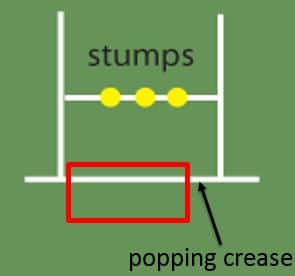
This type of delivery is so effective (especially in limited overs cricket) because it is hard for the batsman to get their bat underneath the ball in order to strike it powerfully. The ball is literally hitting the floor as it reaches the batsman, so it’s very tough to get the leverage that’s required to hit it for a boundary. There is also a high chance it could sneak under the bat if the batsman doesn’t jam his/her bat down quickly enough!
For years, bowlers viewed yorkers as a sure-fire way to keep run rates down and stop batsmen from scoring, and it worked! They would aim to bowl 6 of them in an over and set a field to specifically cover shots down the ground. This was the only real area that most batsmen could hit them! Therefore, if the yorkers were accurate there was a high chance that the fielding side could hold the batting side to singles off every ball! However, the reality of modern cricket is that it just isn’t that simple anymore! Continue reading for my specific advice on how to play the yorker!
How To Detect The Yorker
The first step to facing the yorker is being able to spot it early enough! This is vital because the earlier you can recognise it, the more time you will give yourself to react appropriately. To get better at detecting the yorker early in its flight, I would focus on the following areas:
Watch The Ball From The Hand
This is the most important part of batting as a whole! It’s always vital that a batsman tries to watch the ball from the second it leaves the bowlers hand until it makes contact with the bat, but it’s especially crucial when facing yorkers. When you’re not used to doing this, it can be hard to focus on watching the ball closely every delivery you face. Many batsmen lose concentration, or become too complacent. That is why you’ll see a lot of international batsmen talking to themselves as the bowler is running in to bowl. Many of them will be saying ‘watch the ball’ as a way to remind themselves of what they have to do. This is something that I added to my game and it definitely helped me improve my concentration at the crease!
Maximise Your Practice Time Against The Yorker
If you really want to improve a specific aspect of your batting technique, there’s no better thing to do than spend a couple of hours in the nets practicing it. I feel like the most effective way to practice facing the yorker is to get a fast bowler to actually bowl them at you consistently during a practice session. This is the closest you’ll get to a real match situation! The theory behind this kind of practice is simple: The more yorkers you face, the better you will get at recognising them. Practicing in this way helps us to familiarise ourselves with what the delivery looks like as it leaves the bowlers hand and also as it travels through the air. The more times you can expose yourself to this in the nets, the quicker you will be able to detect it in the future. It is much easier to recognise and respond to physical cues like this if you have already ingrained them into your memory through repetition!
If you have access to a bowling machine, then these are a great way to practice too! However, there are advantages and disadvantages to this approach. The advantage of using a bowling machine is that you can guarantee better accuracy. Once you have set the ball to be delivered on a yorker length, you can keep that setting and work on it for as long as you want. Practicing with a real bowler is slightly different, as the bowler may get tired or just not be able to hit the yorker length very regularly! However, I would still prefer this method rather than using a bowling machine. Batting against the bowling machine does not allow us to see how the yorker looks as it leave the bowlers hand, which is a vital aspect of being able to recognise the delivery early. Instead, we are primarily analysing the flight of the ball! Either method of practice will help you, but I would try to stick to practicing against real bowlers as much as possible! This type of practice helps us to form the habits that we will take into real game situations.
Analyse The Game Situation
One of the best ways to detect yorkers is to learn to anticipate when one is about to be bowled! If you can do this successfully, then you will be able to react to the ball a lot quicker. There are a number of things that batsmen will usually consider when deciding if a yorker is likely to be bowled or not, and I’ll list them here:
- The Stage Of The Innings – There are certain points within a match where bowlers will start to bowl yorkers more regularly. This is most likely to happen at the end of the innings, when the bowlers are trying to stop the attacking onslaught from the batsmen! Many bowlers will choose to bowl multiple yorkers in one over at this stage of the innings, and if a batsman can anticipate these it is more likely he/she will be able to get into a good position to hit them for a boundary!
- Field Placings – You will often see captains of the fielding side set specific fields when they want their bowlers to go into yorker mode. Because the easiest places to hit yorkers are either straight down the ground or slightly wider than this, the fields set will often feature more fielders in those areas. A common tactic used by captains is to bring the third man and fine leg fielders up inside the ring, with the long on and long off fielders back on the boundary. They will also usually have fielders in the ring in the cover and midwicket positions on either side of the batsman to try to stop the quick single. If you see a field like this being set at the end of the innings, there is every likelihood that the bowler will be about to attempt a few yorkers. Obviously, we can’t rely on this totally because the fielding side could be bluffing, but it is often a good indicator and can give us a clue of what is about to happen!
- Tendencies of the Bowler – Certain bowlers have their own reliable deliveries that they will resort to when under pressure. If you have played against a certain bowler before, you may have picked up that they bowl a good yorker and will use it often. This kind of knowledge is very valuable because it helps us to anticipate what ball may about to be bowled. Similarly, if you’re playing against a bowler that you haven’t seen before, but they’ve just bowled two yorkers in a row against you, there’s a high chance that the next ball will be a yorker too. Professional batsmen think about little things like this all the time to try and give themselves an advantage. During matches, try to put yourself in the mind of the bowler and ask yourself where you would bowl the next ball if you were in their shoes! Facing a fast bowler at the end of the innings is a mental battle as well as a physical one! It’s all about who can hold their nerve. The more experience of playing cricket that you get, the more reliable your cricketing intuition will be in these moments.
How To Defend Against The Yorker
There are many times where we will have to resort to defensive tactics in order to deal with a well bowled yorker. The key to defending against this delivery is simple. We just have to make sure that we bring our bat straight down quickly and ensure that we do not leave a gap between the bat and the ground. This is the most important point! Leaving a gap between bat and ground means there is a chance the ball could sneak through, which would likely result in us being bowled!
One of the most effective tips that will help you defend against the yorker is to lower your backlift. Backlift is the term given to the amount that we lift the bat up into the air before we strike the ball, and some batsmen raise the bat a lot higher than others. Batsmen who have a very high backlift will struggle to react and get the bat down to the ground as quickly as a batsman with a low backlift. An example that I always use when I talk about this is Brian Lara! Despite being one of the greatest batsmen ever, he had an incredibly high backlift. This meant that other teams consistently targeted him with the yorker!
One of the most deadly bowlers of this type of delivery was Wasim Akram of Pakistan. His yorkers were especially troublesome because he could get the ball to swing a long way along with bowling at a high pace. I remember ex-England captain Nasser Hussain saying that in order to deal with these fast swinging yorkers, the England batsmen would all try to lower their backlift. Some players will choose not to do this as it feels unnatural. But if you’re really concerned about your ability to defend this delivery then it’s something you may want to consider!
Obviously, not all yorkers have to be defended with the bat. If you can pick up the line of the delivery nice and early, then you may choose to play no shot at all and leave the ball alone!
How To Effectively Change Your Body Position At The Crease
Now this is where the real fun begins! In this section I’m going to go over ways that you can manipulate your body position to make it easier to hit yorkers, and also what kinds of attacking shots you can play against them!
Basically, the only way you are going to be able to hit yorkers for boundaries consistently is by learning to adjust your position at the crease as the bowler delivers the ball. This helps to create the leverage and room that you need to get some power behind your shots! If you can learn to move in the right ways, there is more chance you’ll be able to hit the ball out of the middle of your bat! You’ll become a much more dangerous batsman if you can add the following techniques to your game…
Advancing Down The Pitch To Turn The Yorker Into A Full Toss
Yorkers are effective because they are speared in towards our feet. As I told you in the opening section of this post, they’re incredibly hard to get your bat underneath! But what if we were able to move our feet and change our position on the crease? This can change things dramatically! If we move forwards towards the bowler as they deliver the ball, then we can meet the ball while it is still in the air, rather than waiting for it to bounce! We are essentially transforming the delivery into a full toss with a simple forwards movement! As most batsmen will know, it is much easier to hit a full toss for a boundary than a yorker!
If we’re going to make movement like this against a fast bowler, it is almost always going to be pre-meditated. Pre-meditated means that you will decide that you are going to do this before the bowler has begun their run up. These types of movements and shots are risky, but we as batsmen must do our best to minimise the amount of risk involved. It’s very important that we stay balanced and keep our eyes on the ball so that we can still hit it even if we do end up slightly out of position! When the elite international batsmen make a pre-meditated movement, they will always ensure that they are able to adjust halfway through the process and play a different shot if the ball isn’t bowled where they thought it was going to be! Jos Buttler is great at this. He will prepare to play his version of the ramp shot by turning his body to face the bowler and keeping his bat vertical, but the fact that he keeps his body upright means that he is always in a position where he can quickly change to another shot if he needs to.
If I was looking to move forwards towards the bowler, I would try to do it in either of the following ways:
- The first one is taking one or two steps down the pitch towards the bowler. If you choose this option, then it is vital that you try to keep your head as balanced and as still as possible even as you are on the move. Keeping the head as well as your body balanced gives you the best chance of playing a good shot regardless of what delivery the bowler chooses to bowl. Your movement should occur just as the bowler has entered their delivery stride. This is usually around a second before they release the ball! If they bowl a yorker, you will be well positioned to hit the ball on the full! If they choose to bowl a normal length delivery, you will still have your head and body in a good position to be able to play the ball as normal. I would concentrate on advancing on a straight path towards the bowler because this way you will be able to cover the stumps better with your pads/body. If the ball hits you on the pads after you have come down the wicket, the umpire will be less likely to give you out because you have increased the distance between yourself and the stumps! This makes umpires a lot less certain if the ball would have gone on to strike them!
- The second way you can move forwards towards the bowler is to take one large stride down the wicket with your front foot. Again, this movement should occur in the moment right before the bowler releases the ball! Tillakaratne Dilshan would often do this before playing his famous scoop shot. He would push his front foot forwards while collapsing his back leg and going down onto one knee. Alongside this he would adjust his grip so that his bat was extended out in front of him. From here he was in the perfect position to reach out with the bat and make contact with the ball before it bounced. If you choose to move forwards in this way, it’s important to not stride forward too far with your front foot, as this can lead to you being off balance and falling over as you try to hit the ball!
These techniques I’ve mentioned above are really easy to practice in the nets! The more you work on these kinds of movements, the more used to performing them you will become. If you’re practicing them against fast bowlers, make sure you’re wearing all the right protective gear! There’s always a chance you could misjudge a ball and end up getting hit! But this helps us to learn! If you don’t want to try this against real bowlers straight away, then you can use a bowling machine if you have access to one, or just get someone to give you some throw down deliveries! These can be easier, less intimidating ways of getting used to this forwards movement. Plus, with bowling machines and throw downs you can tell the machine/person exactly where you want them to pitch the deliveries. Once you have gotten used to the movement you can try to play it against real bowlers!
Retreating Back Into Your Crease To Turn The Yorker Into A Half Volley
This tip is as simple as it sounds! If you’ve received a few yorkers in quick succession, or you’re playing against a bowler who is known for bowling plenty of them, you may wish to take a step backwards rather than forwards! A backwards step means that we put a bit more distance between the pitching point of the yorker and our bat. This allows the yorker a bit more room to bounce higher before it gets to us, which essentially turns it into a half volley! Half volleys are much easier to hit out of the middle of our bat!
Again, this is mainly a pre-meditated movement that occurs just before the bowler releases the ball! It is not necessary to move back very far; a small movement can make all the difference! I’ve included the diagram below to show the kind of depth you should be looking to get when you choose to retreat.
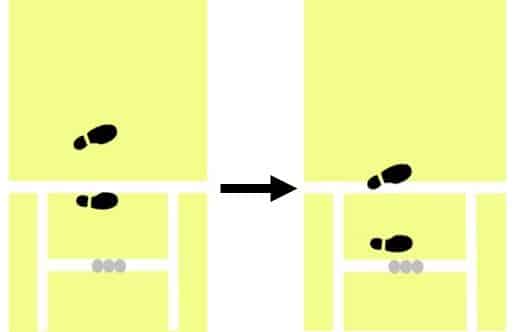
Because the movement is not very big, it’s easy to maintain good head position and balance throughout the movement, which is key if we want to watch the ball on to the bat and play a good shot! Once you have shifted backwards, you can pretty much play any shot you like! In this situation, I prefer to stay technically correct and play the drive.
The obvious danger with this kind of movement is that we could potentially hit our own stumps with our feet or the bat! This is why practice is vital. You have to experiment in the nets so you know exactly how much backwards movement you can get away with.
Adjusting Your Grip On The Bat
I remember Jos Buttler saying in an interview that when he is facing a bowler who is bowling some good yorkers, he will change his grip slightly. Instead of holding the bat with the conventional grip, he will ‘open up the face’ a bit more. This basically means that when he is in his batting stance, he will point the face of the bat slightly more towards the off side instead of straight down the wicket. Pointing the face of the bat in this direction allows Jos to get down low and play the yorker with a horizontal bat, rather than a vertical bat. When using the bat vertically against the yorker, you will be more likely to strike the ball with the toe end! But when we play horizontally in a similar way to a hockey player, it allows us to use the thicker parts of the bat to strike the ball instead! As I mentioned, Buttler aims to get as low to the ground as possible when he does this, and this helps him to slap the ball square of the wicket rather than playing it straight! The photos below demonstrate the change in grip as well as the position that Buttler will aim to get his body in to!
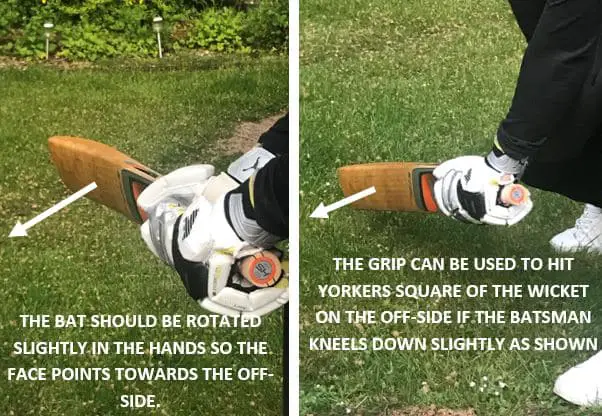
This is another technique that will need a decent amount of practice because batsmen aren’t really coached to bat like this! I’d recommend getting someone to throw you some deliveries first. Start off underarm and use these slower deliveries to get used to the grip and get your body in the right position. As you become more comfortable, you can move to overarm throw downs before trying to use it against proper fast bowling!
What Shots Can Be Used To Attack The Yorker?
All batsmen will need a few shots in their locker that they can use to attack the yorker! I’m going to share a few of the most popular ones with you here. If you can use these successfully, then it will allow you to keep the score ticking over even when the bowlers are bowling well! It will also force them to adjust their game plans against you!
The Ramp Shot
This is one of the most famous shots in the modern game! It allows the batsman to deflect the ball over his/her own head behind square on both sides of the wicket. The diagram below explains the areas where the ramp shot can be hit!

Batsmen will usually decide to play the ramp before the bowler has delivered the ball. It is very hard to decide to play the ramp while the ball is in the air because it requires us to alter our body position and grip so much! If you want to play this shot against the yorker, follow these steps:
- Your first task is to advance towards the bowler in one of the ways that I covered in the previous section. To play the ramp to this delivery, it is vital that we get the bat to the ball before it bounces! My favourite way to do this is by taking a decent length stride down the wicket towards the bowler with my front foot. Seeing as this movement occurs just before the bowler has released the ball, I’ll make sure that I get my body in a nicely balanced position. This means that I can adjust and play a different shot if I need to. Don’t stride so far down the pitch that you feel off balance!
- Keep your eye on the ball as it leaves the bowlers hand. If the delivery seems like it is going to be a full-pitched ball that is close to yorker length, extend the bat out in front of you and rotate it so that the face of the bat is pointing upwards.
- Now you need to get the bat underneath the ball, and allow the ball to glance off it. The face of the bat should be angled towards the direction you want the ball to travel in. If you are looking to get lots of elevation on the ball, you can use your wrists to achieve this. As the ball makes contact with the bat, use your wrists to give the bat a little flourish in the desired direction of the shot. This should help you to clear the ball over the head of any fielders who are a little bit closer to you!
- No matter what direction you are trying to hit the ball in, you must try to get your head out of the way of the shot. The ball can come off the bat at a fast pace, and you don’t want it smashing into your helmet! Focus on watching the ball until the last second and then moving your head away from the line of the shot!
Most ramp shots are played down towards the fine leg fielding position. If you’re planning to play this shot, have a look around before the bowler runs in to bowl and take note of where the fielders are behind you. If the opposing captain has no fielder at fine leg, then you’ll know you can play the ramp shot however you like. If the fine leg fielder is inside the ring rather than on the boundary, you may need to put a bit more power on the shot to clear the fielder! The same is true if you’re playing the ramp behind square on the off side down towards the third man fielding position. If the opposing captain has someone on the boundary at third man, as well as fielder(s) in the slip cordon, playing the ramp on this side of the wicket may not be a great idea! Make sure you target the gaps and try to dictate the game to the bowler!
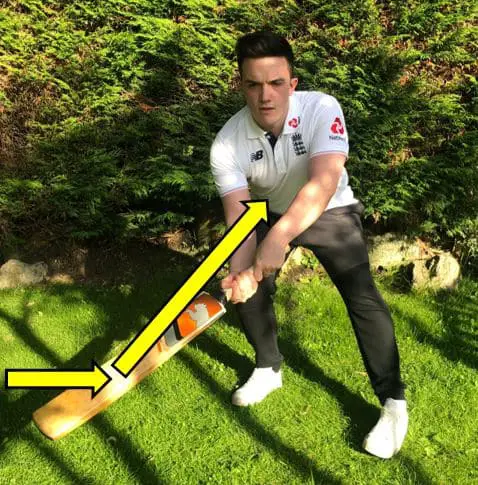
The Sweep/Reverse Sweep
These two shots are very similar to the ramp shot, except for the fact that they are usually played more along the ground rather than in the air. If you look at the two diagrams below you can see the areas that both shots are used to target!
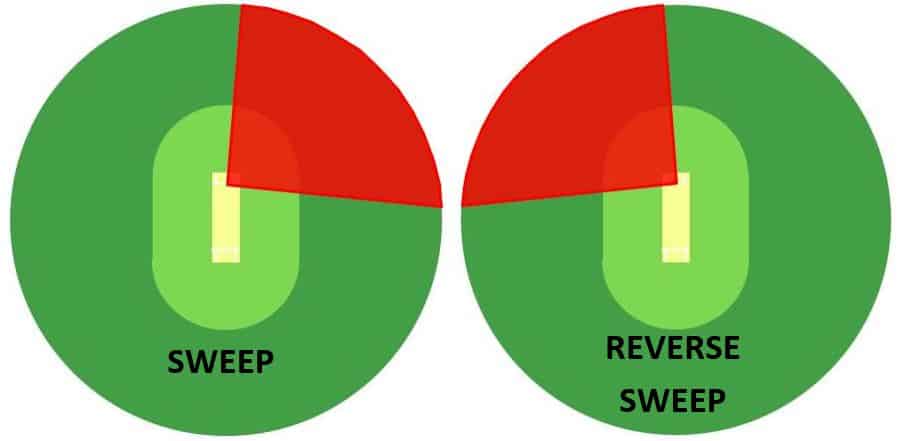
Both the sweep and the reverse sweep are pre-meditated shots. Batsmen will usually only choose to play them against a fast bowler if they notice a particular gap in the field that they feel they can easily exploit! Here are the steps to playing them:
- To play either of these shots, you should start by taking a stride down the pitch towards the bowler with your front foot. Again, the length of the stride should be comfortable! Don’t over-stretch!
- Watch the ball closely! If the delivery isn’t on a yorker length like you hoped then you need to detect this and adjust quickly!
- If the ball is very full/yorker length, sink your body a little closer to the ground, extend the bat out in front of your front leg and rotate/adjust it in your hands. For the regular sweep shot, the bat only needs to be rotated slightly so that the face is pointing towards the leg side of the field. The reverse sweep is slightly more complex and it requires us to cross our wrists in order to point the face of the bat towards the off side.
- Now you need to make contact with the ball. Move your arms and strike the ball in the direction you desire. You can also choose to flex your wrists a little as you hit the ball to get a little extra power! This isn’t always necessary though! The great thing about playing the sweep/reverse sweep against a fast bowler is that we can use their pace against them! Even if we only get a small amount of contact on the ball, it will come off the bat at a high speed!
If you want to hit the sweep shots square of the wicket, it is advisable to strike the ball a bit earlier, and apply a bit more power by using your wrists. If you’re aiming to get the ball down towards fine leg or third man, then you will require a thinner contact of the bat! You won’t have to hit it nearly as hard. Take a look around the field to see where the gaps are before the bowler starts their run up, then you can focus on which gap to try and target!
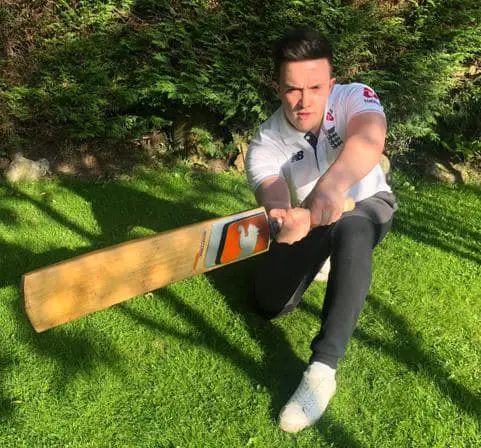
The Drive
The drive is a much safer and simpler option than the two shots I have explained above, and it can be separated into three sub categories: The cover drive, the straight drive & the on drive. The straight drive is obviously played straight back down the ground, while the cover drive is slightly more to the off side of this. The on drive is played slightly to the leg side of straight! To play these shots effectively against the yorker we have to change our position on the crease! Let’s see how to do it:
- First you need to decide whether you’re going take a few steps down the pitch towards the bowler, or retreat back into your crease. Once you have decided, you should execute this movement just before the bowler releases the ball. When the movement has occurred, you should be in a solid batting stance, ready to play a shot.
- Watch the ball as it leaves the hand of the bowler. If the ball is a yorker, then you should now be in a good position to take advantage of it. If you have taken steps towards the bowler, you will be able to hit the ball like a full toss. If you have retreated backwards, you may have turned the yorker into a half volley.
- Read the line of the delivery. If the line is towards the off side of your body, you should look to play a cover drive! If the delivery is aimed towards the stumps or your feet, then you can choose whether to play the ball straight down the ground or play the on drive instead.
- All the drive shots are played in roughly the same way. Take a step forwards with the front foot and bend the leg slightly, getting your weight over your front knee. Angle the face of the bat in the direction you want to hit the ball and strike through that line. Try to ensure that the bat comes through nice and straight. You can do this by keeping your front elbow high as you play the shot. I’ve included a photo of this below!
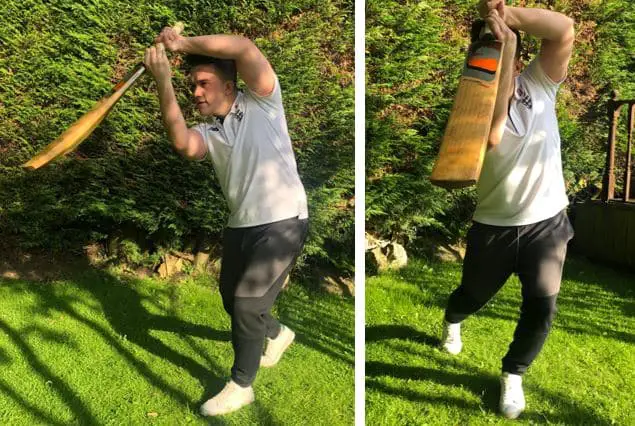
Lofted Shots Into The Leg Side
Let’s face it, everyone loves to attempt a heave into the leg side every once in a while! Well, if that’s you, you’re in luck! I included this specifically for those of you that can’t resist that type of shot! If we get into the right position before the ball is bowled, then the yorker is as good of a candidate as any to be smacked over mid-wicket for 6. If you don’t know where mid-wicket is, then look at the diagram below to see the areas you should be targeting with these lofted leg side shots!
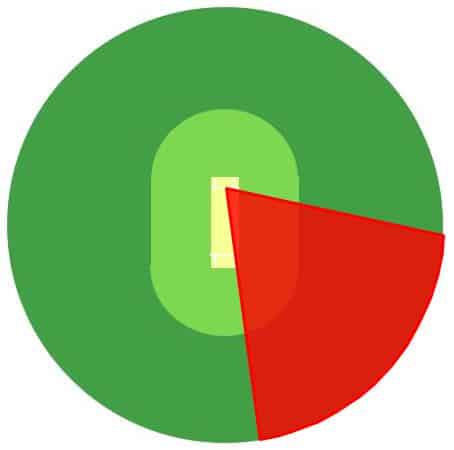
- To be able to play this shot against the yorker, you will have to take a few steps down the pitch towards the bowler just before they release the ball.
- Watch the ball closely. If the delivery is a yorker, then your movement forwards will have transformed it into a full toss! Now pay attention to the line of the ball. If it is on the line of the stumps or your body then this delivery is perfect for you to hit in the air into the leg side.
- For this type of shot you should establish a strong base from which to hit. You do this by widening the distance between your front and back foot. Like with all the shots I’ve mentioned, the distance between the feet should be comfortable, allowing you to be well balanced. This is the most important aspect of this shot!
- Once you have the solid base, you are free to bring the bat forward and through the line of the ball. The face of the bat should be angled towards the direction that we’re trying to hit the ball in.
- As you make contact with the ball, allow the hands to follow through the line of the shot. This is how we get the power!
You should focus on hitting the ball far. Don’t focus on hitting the ball high! Believe it or not there is a difference between these two things! If you’d like to read my guide that will teach you how you to hit a cricket ball further, click here! It’s one of my posts that I’m most proud of, and it’ll definitely be able to help some of you out!
The Square Drive
I chose to separate the square drive from the other drive shots because this one is played in a slightly different way when we receive a yorker! The square drive is usually hit square of the wicket on the off-side, which you can see in the diagram below.
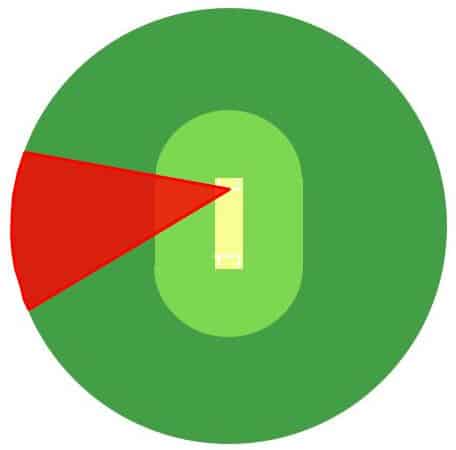
The shot is played in the following way:
- Start your motion with a comfortable stride down the pitch with your front foot.
- Adjust your grip on the bat slightly and open the face. If you have done this correctly, the face of the bat should be pointing slightly more towards the off side than it was before.
- Watch the ball closely. To play the square drive you are looking for a very full/yorker length ball that is outside the off stump.
- If the ball is in the correct area, get down nice and low to the ground by collapsing your back leg. You may feel more comfortable getting on one knee to play the shot!
- Use the bat in a similar way to how a hockey player would. This shot is more of a horizontal cross batted ‘slap’. Your bottom hand must be strong as this is what will control the bat throughout this movement.
I mentioned this shot earlier in this post, in the ‘adjusting your grip on the bat’ section, but I’ll reiterate why it’s so effective again here. The fact that the shot is played with a horizontal bat allows us to get the middle of our bat closer to where the ball is pitching. If we were to play the same delivery in a conventional way, with our bat in a vertical position, we wouldn’t be able to get anywhere near the same amount of power on the ball! I really like this shot, I’d recommend trying it out if you haven’t already!
Conclusion
Thanks to all of you for reading this post! The yorker is a dangerous delivery but I hope I’ve given you some new ideas as to how you can play against it. Your next job is start practicing some of the techniques that I have spoken about in the nets or at home! Have some fun and see what works for you. As my final point, I’d like to make it clear that you don’t have to make these aggressive movements very often, and you don’t have to play an aggressive shot to every yorker you ever face! It’s ok to defend sometimes! However, it’s vital that you have the ability to attack the yorker if you really need to! It really can ruin a bowler’s whole game plan if they know that’s what you are capable of!
